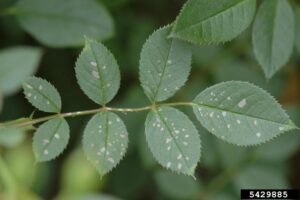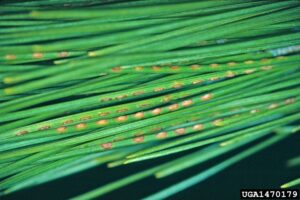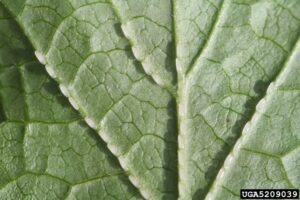Sawflies are frequent pests in the landscape that attack a wide variety of plants, from ornamental flowers to large trees. You might start to see them damaging plants around this time of year as the first generations hatch and begin to feed on foliage. They are often mistaken for caterpillars, which are the larval stages of butterflies and moths (Order Lepidoptera). However, sawflies are actually wasp-like insects (Order Hymenoptera).
Let’s review how to tell them apart. Products that are labelled for caterpillars do not always work on sawflies, so proper identification is important.
- The most reliable characteristic are the prolegs. Sawflies have 6+ pairs of prolegs, or false legs, while caterpillars have < 6 pairs of prolegs. (Fig. 1)
- When disturbed, sawflies will lift their posterior into an “S” shape. Caterpillars don’t display this behavior. (Fig. 2)

Figure 1. Left: Sawfly larvae. Image: John Obermeyer, Purdue University. Right: Tomato hornworm. Image: Gerald Holmes, Strawberry Center, Cal Poly San Luis Obispo.

Figure 2. Sawflies displaying characteristic “S” shape. Image: Gyorgy Csoka, Hungary Forest Research Institute.
Integrated management recommendations
Early in the year, before hatching starts, look for sawfly oviposition on your plants. This will vary depending on the species of sawfly. For example, the European Pine sawfly eggs look like yellow-orange spots evenly spaced on the needles (Fig. 3). The Bristly Roseslug sawfly uses her ovipositor to cut a slit into the leaf petiole where she inserts eggs. The gooseberry sawfly lays eggs on a leaf vein (Fig. 4).
- Figure 3. European pine sawfly eggs. Image: A. Steven Munson, USDA Forest Service.
- Figure 4. Gooseberry sawfly eggs. Image: Whitney Cranshaw, Colorado State University.
If the eggs are readily visible, manual removal will help reduce the populations. This is best accomplished in early spring before the eggs hatch. Use a tool to smash the eggs, or prune of the affected plant material.
You may not notice any problem on the plant until you start to see holes appearing in the foliage. Monitor regularly in the spring for holes and “window pane” damage (Fig. 5). This is the time of year when sawflies are hatching, so don’t wait any longer to check your plants. Sawfly management is best accomplished when the larvae are still small. Prune or shake off the larvae from the plant, or spray with a biorational material so as not to disturb natural enemies and cause a secondary pest outbreak later in the summer.

Figure 5. Bristly roseslug feeding damage. Brian Kunkel, University of Delaware.
For more information on sawfly biology, check out this five-minute video: Slaying Sawflies with Purdue Plant Doctor.
Specific management recommendations can be found on the Purdue Plant Doctor website. Type “sawfly” into the search and click on the species you would like to read more about!

